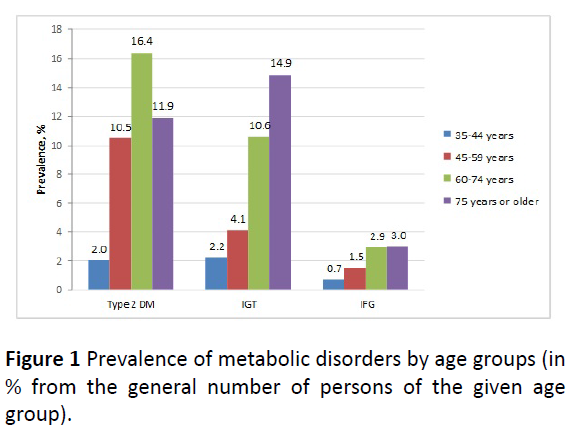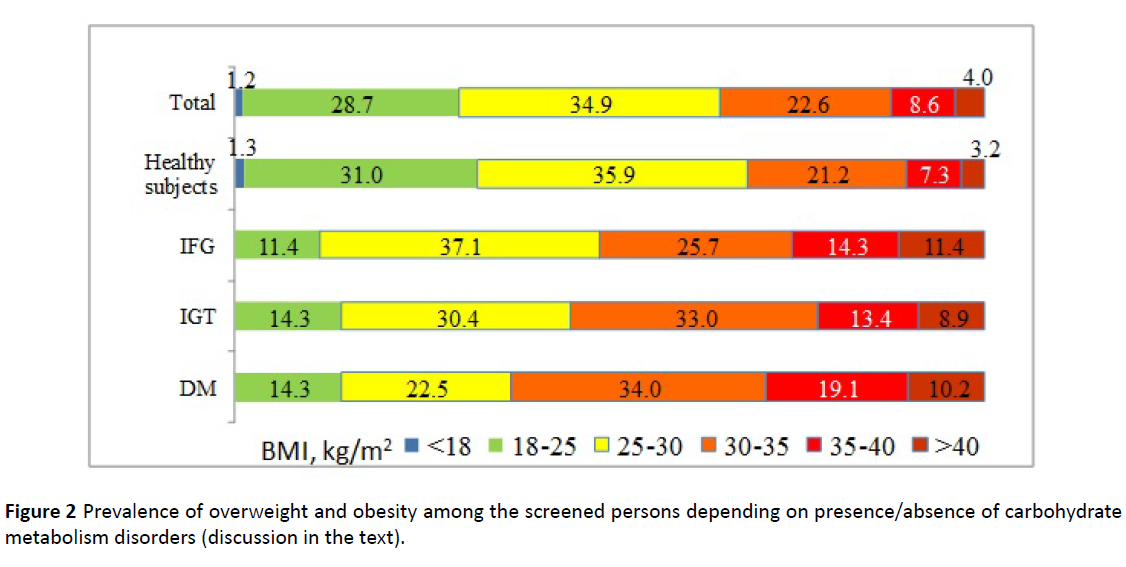Alieva AV1*, Ismailov SI2 and Rahimova GN3
1Republican Specialised Scientific-Practical Medical Centre of Endocrinology, Uzbekistan
2Tashkent Pediatric Medical Institute, Uzbekistan
3Tashkent Institute of Postgraduate Doctors Education, Uzbekistan
- *Corresponding Author:
- Alieva AV
Republican Specialised Scientific-Practical Medical Centre of Endocrinology, Uzbekistan
Tel: +99893381-45-60
E-mail: annaalieva@yahoo.com
Received Date: November 29, 2018; Accepted Date: December 10, 2018; Published Date: December 17, 2018
Citation: Alieva AV, Ismailov SI, Rahimova GN. (2018) Epidemiology of Diabetes and Prediabetes in Uzbekistan: Screening Results. Health Sci J Vol.12.No.6:609. DOI: 10.21767/1791-809X.1000609
Copyright: © 2018 Alieva AV, et al. This is an open-access article distributed under the terms of the creative commons attribution license, which permits unrestricted use, distribution and reproduction in any medium, provided the original author and source are credited.
Keywords
Epidemiology; Diabetes; Health
Introduction
Background
Growth of type 2 Diabetes Mellitus (DM) prevalence leaves no doubts that the disease is not only medical, but also a social threat to the world population. Also, there is an increase in the number of persons with DM risk factors, with prediabetes – impaired glucose tolerance (IGT) and impaired fasting glycemia (IFG) [1]. Diagnostics of all these conditions is easy and accessible at all levels of the public health institutions, however, in Uzbekistan, as well as in many other countries of the world, there is a discrepancy between data on registered patients and data of epidemiological studies [2-4].
So, by the beginning of 2017, prevalence of type 2 DM in Uzbekistan is 0.73% of adult population, according to regional endocrinological dispencaries clinics, whereas data of epidemiological study in 2005, and calculations of International Diabetes Federation [4], assume, that 5.05% of population aged 20-79 years has type 2 DM.
There are even more discrepancies about IGT prevalence and data on IFG are absent.
Presence of real epidemiological data on prevalence of DM, prediabetes and their risk factors is extremely necessary for correct planning of effective work of the public health system which finally purpose is improvement of quality of life of the population.
Materials and Methods
We performed screening for DM and prediabetes among urban and rural population aged 35 years or older in Tashkent, Qashqadarja and Khorezm regions irrespective of nationality. Sample was formed by a method of random numbers; sample was formatted via weighed cluster design. In total 711 men and 1464 women (2521 persons) were screened.
Study was done by the same group of endocrinologists in all regions.
Study included filling on a questionnaire based on Finnish Diabetes Risk Score with an estimation of risk of type 2 development [5].
Fasting and post-load (oral glucose tolerance test with 75 g of glucose) blood glucose was measured in all participants in capillary blood with iXell glucose meters (Poland).
Prediabetes and diabetes were diagnosed according to the international recommendations [6].
Statistical data analysis was performed using computer program STATISTICA 6.0 Microsoft Excel. Data on prevalence are presented in the form of percent to number of persons of corresponding age and sexual group.
Study Results
Data on type 2 DM, IGT and IFG are resulted in Table 1.
Table 1: Prevalence of type 2 DM, IGT and IFG (in %) according to the results of screening in Tashkent, Qashqadarja and Khorezm regions of the Republic of Uzbekistan depending on age, sex and urbanization*.
| Carbohydrate metabolism disorder |
Prevalence |
| Total |
Age groups |
| 35-44 years |
45-59 years |
60-74 years |
75 years or older |
| Type 2 DM |
Total |
7.9 (8.7/7.5) |
2.0 (2.4/1.8) |
10.5 (11.4/9.9) |
16.4 (16.0/16.7) |
11.9 (5.9/14.0) |
| Urban |
7.3 (9.2/6.7) |
1.4 (2.4/1.2) |
11.0 (13.4/10.0) |
10.5 (10.8/10.0) |
7.7 (-/9.4) |
| Rural |
8.4 (8.4/8.3) |
2.4 (2.5/2.4) |
10.0 (10.3/9.9) |
25.8 (25.0/26.0) |
17.8 (10.0/24.0) |
| IGT |
Total |
4.4 (2.6/5.3) |
2.2 (1.4/2.5) |
4.1 (2.7/4.8) |
10.6 (6.0/12.8) |
14.9 (-/20.4) |
| Urban |
5.3(3.7/5.9) |
2.6 (1.2/2.9) |
4.5 (4.2/4.6) |
10.0 (6.7/11.5) |
23.1 (-/28.1) |
| Rural |
3.7 (2.0/4.7) |
1.9 (1.5/2.1) |
3.8 (1.9/5.1) |
11.7 (5.0/15.0) |
3.6 (-/5.9) |
| IFG |
Total |
1.4 (0.5/1.8) |
0.7 (-/0.9) |
1.5 (0.2/2.1) |
2.9 (3.0/2.8) |
3.0 (-/4.1) |
| Urban |
1.8 (0.7/2.2) |
0.7 (-/0.9) |
2.2 (0.7/2.7) |
3.7 (1.7/4.6) |
(-/-) |
| Rural |
1.0 (0.4/1.4) |
0.7 (-/1.6) |
0.9 (-/1.6) |
1.7 (5.0/-) |
7.1 (-/11.8) |
*Data are presented as the total prevalence in % (prevalence among men/prevalence among women) of corresponding age group and urbanization level.
In our study, 7.9% persons had type 2 DM and 74% of them were diagnosed during our screening. Prevalence of type 2 DM among men aged 35 years or older was 8.7%, among women – 7.5%. IGT was revealed in 4.4% of screened persons (in 2.6% of men and in 5.3% of women). IFG was revealed in 1.4% of screened persons (in 0.5% of men and in 1.8% of women).
There is a tendency to increase in prevalence of all revealed metabolic disorders with age (Figure 1).

Figure 1: Prevalence of metabolic disorders by age groups (in % from the general number of persons of the given age group).
We have noticed that type 2 DM is more prevalent among men of young and middle age, and among women of senior age. Prevalence of IGT increases with age in both men and women, irrespective of degree of urbanization, but is more frequent in female. Prevalence of IFG also increases with age irrespective of urbanization degree; but we consider that we are unable to conclude if there are any sexual distinctions in prevalence because of small number of the given group.
The results of estimation of type 2 DM risk FINDRISK, are discussed by us in other publication [7]. Here we present one of the questionnaire points, namely body mass index (BMI). We analyzed prevalence of overweight and obesity among the screened persons (Figure 2).

Figure 2: Prevalence of overweight and obesity among the screened persons depending on presence/absence of carbohydrate metabolism disorders (discussion in the text).
Only 28.7% all screened population had normal weight, which corresponds to BMI 25-28 kg/m2, and 70.1% had overweight or obesity. Even among persons without any revealed carbohydrate metabolism disorders, only 31% had normal weight.
Discussion
Data on prevalence of type 2 DM obtained through disease registration on referral to doctor differs with the data received during epidemiological studied in all countries of the world with no exception, though and degree and reasons of discrepancy of data varies depending on the country [4,8]. Therefore the strategy of active revealing of DM every 5 years recommended by WHO [9] is urgent and, in our opinion, should be carried out on a regular basis, inter alia for competent scheduling of diabetological services in the country and maintenance of all population with the necessary adequate qualified care, medical products and self-control means.
Results of our study showed, that the real prevalence of type 2 DM 10 times exceeds the data based on the registered patients. It could mean that only one of 10 patients receives the adequate qualified care and lives a high-quality life. Actually, we believe, that the situation is different. Substantial part of patients is observed by private clinics, passing by registration in endocrinological dispensaries. It complicates planning of necessary medical care, starting from work of team of experts to provision of glucose and lipid lowering and hypotensive medicines and self-control tools.
According to IDF calculations, prevalence of IGT in the Republic is 5.69% among persons aged 20-79 years. Prevalence of IGT in Uzbekistan was studied by Ibragimov [10], (age group 15-60 years) – 6.1% [10], by Sultanov (age group 35 years and older, urban population) – 12.2% [11]. In our study IGT was more prevalent in urban population (5.3% comparing to 3.7% in rural population) with increase of prevalence from 2.2% in young age to 14.9% in senile age group. Therefore, most likely, divergences in results of abovementioned studies are caused by a different proportion of age groups.
For the first time in our study we received data on prevalence of IFG in Uzbekistan.
High prevalence of overweight and obesity in persons with and without carbohydrate metabolism disorders causes concern. Over 35% of the Republic population has obesity of various degree and about 35% are overweight. So, 70% are already at risk of development of cardiovascular diseases within the next 10 years.
So, in our study we obtained data on actual prevalence of type 2 DM, IGT and IFG in Uzbekistan depending on age, sex and urbanization. Data on prevalence of overweight and obesity are deplorable and testify the necessity of preventive work with population concerning healthy lifestyle starting at the early childhood.
Conclusion
• According to the results of screening among urban and rural population aged 35 years and older, living in Tashkent, Khorezm and Qashqadarja regions of the Republic of Uzbekistan in 2015-2016, prevalence of type 2 diabetes is 7.9%, prevalence of IGT is 4.4%, prevalence of IFG is 1.4%.
• Actual prevalence of type 2 DM 10 times exceeds the data obtained through registration at endocrinological dispensaries. In 74% of patients with diabetes, disease was diagnosed during the screening.
• There is a tendency to increase in prevalence of all revealed carbohydrate metabolism disorders with age.
• Over 35% of the Republic population has obesity of various degree and about 35% are overweight. Among persons without any carbohydrate metabolism disorders only 31% had normal weight.
23841
References
- Dedov II, Melnichenko GA, Fadeev VV (2007) Endocrinology M: GEOTAR-Media, pp: 268-270.
- Akbarov ZS, Alieva AV, Alimova NU, Tashmanova AB, Sadykova AS, et al. (2016) Screening for diabetes mellitus and prediabetes in Tashkent. J Theor Clin Med, pp: 50-56.
- Ismailov SI, Rakhimova GN, Juraeva AS (2012) The relevance of epidemiological studies of type 2 diabetes and intermediate hyperglycemia prevalence in Uzbekistan. J Theor Clin Med, pp: 6-12.
- Saaristo T, Peltonen M, Lindstrom J, Saarikoski L, Sundvall J, et al. (2005) Cross-sectional evaluation of the Finnish Diabetes Risk Score: a tool to identify undetected type 2 diabetes, abnormal glucose tolerance and metabolic syndrome. Diab Vasc Dis Res 2: 67-72.
- Definition and diagnosis of diabetes mellitus and intermediate hyperglycemia (2006) Report of a WHO/IDF consultation, pp: 46-56.
- Ismailov SI, Alieva AV, Rakhimova GN (2017) Assessment of 10-years risk for type 2 diabetes in Uzbek people: screening results. Metabolic syndrome and other dismetabolism disorders in different areas of medicine.
- World Health Organization: International Diabetes Federation Report of a WHO Study Group. Geneva, World Health Org, 2006.
- Ibragimov TK (1992) Prevalence of diabetes in the regions of Uzbekistan considering risk factors and measures for its prevention. pp: 32-36.
- Sultanov BA (2008) Prevalence of type 2 diabetes and IGT in three cities of Uzbekistan. pp: 22-28.







